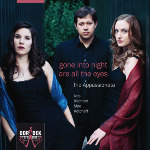
Songs
- artist:Trio Appassionata
- release year:2014
- style(s):20th Century, Contemporary
- country:USA
- formats:CD (Compact Disc)
- record posted by:Odradek Records
- label:Odradek Records
- buy this record
The Trio Appassionata, whose members originate in Brazil, Spain, and the US, met as students at Peabody, and pay tribute to their shared “American" musical heritage as an ensemble with a disc dedicated to four generations of American composers - Charles Ives, Leon Kirchner, Eric Moe, and Thomas Kotcheff, their fellow classmate at Peabody. The works chosen range from delicate and fragile to boisterous and even raucous. They run the full gamut of textural possibilities, from complete unity of voice, to dialogue, to opposition, and all the way to the complex layering of different voices - all however are driven by expressive imperatives.
The disc takes its title from the first work of the album, Kotcheff’s "gone into night are all the eyes", which was commissioned by the trio for this CD with support of the Presser Foundation and completed in 2013. The title itself, taken from the opening line of a poem by Jorge Luis Borges from his collection Poems of the Night, suggests the evocative, nocturnal and ambiguous tone of the work, which explores the fleeting quality of things perceived at night without ever becoming melancholic. It’s a great work by a young Californian composer (born in 1988), that proves that the piano trio is alive and well as a form, and leads one to expect that Kotcheff is well on his way to becoming one of the leading faces of new music in the USA.
We Happy Few by Eric Moe (b.1954), a professor of composition at the University of Pittsburgh, has a title which refers to what the composer calls ‘the paradoxical artistic economics of chamber music, wherein less is generally more’. He goes on to suggest that the closing lines of Keats’s Ode to Melancholy ‘may offer an entrance to the work’s complex emotional climate’. If the initial tempo marking – ‘blues feel, rollicking, exuberant’ – seems worlds away from the poetry of Keats, it prepares us immediately for a world where cultures clash and expectations are challenged: a world in which Moe delights. At times the music seems on the verge of becoming something wild and unconstrained, at other times on the point of becoming lyrical. The end of the work is unexpectedly becalmed and makes what the composer calls a ‘happy-tragic’ conclusion - a paradoxical end to a paradoxical piece.
Leon Kirchner (1919-2009), as one of Schoenberg’s foremost American pupils, is stylistically the most European of the composers on this disc. Copland described Kirchner's music as being 'almost frightening in intensity' and in works like this it is possible to understand Kirchner's stated desire to create 'a verdant world in continuity with tradition.’ His Piano Trio (1954) is in many ways the most conventionally expressive of the four pieces, its handling of material and texture in a direct line of descent from the Germanic 19th century tradition. Its two movements are beautifully balanced in size, shape and material. They are linked by the final chord of the first movement becoming the first chord of the second and thus acting like a hinge between two panels.
Charles Ives (1874-1954) conceived his trio as a reflection of his college days at Yale, and the piece thus fittingly concludes this disc commemorating this young trio’s formation as students at conservatory. Begun in 1904, like most of his works, it had a long gestation period: it was completed in 1911, revised a few years later and not performed publicly until 1948. The first movement is self-consciously serious in tone and recalls a talk by an elderly Professor of Philosophy. The second movement brings a complete change of tone: the title 'TSIAJ' is an acronym for 'This Scherzo Is A Joke’. It is energetic, exciting and bewildering music of student high spirits. The final movement restores a more serious tone and Ives suggested it was 'partly a remembrance of a Sunday service on the campus’. It closes with the hymn tune 'Rock of Ages'. The anticipated final cadence is left hanging. A nocturnal ambiguity returns.


